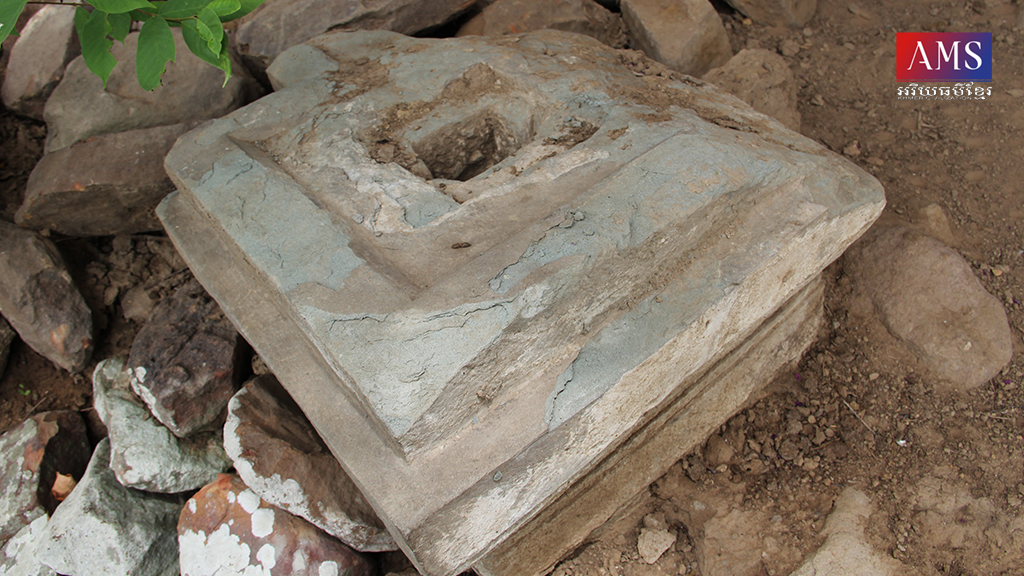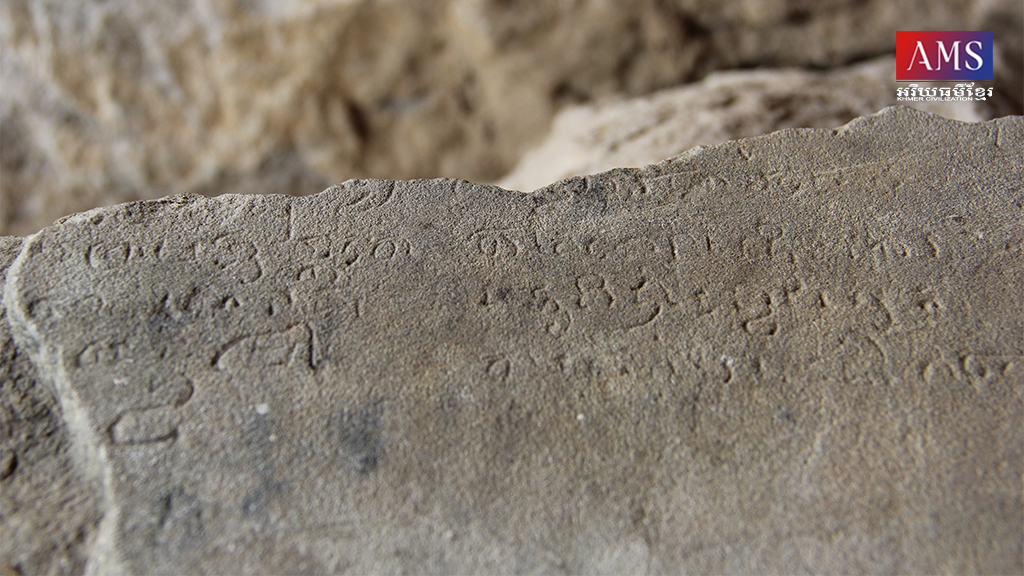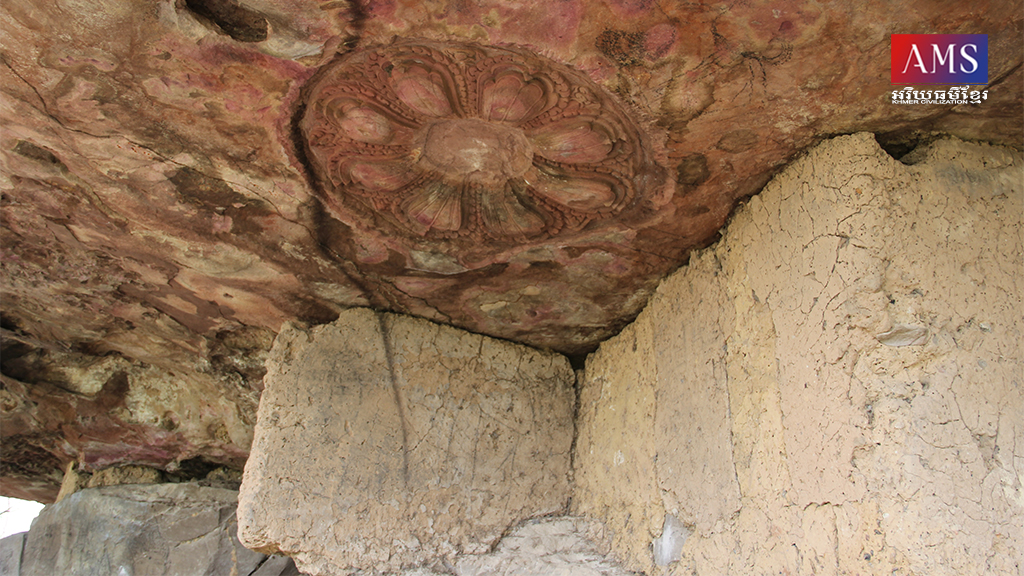ពើងឆ័ត្រ ស្ថិតនៅជើងភ្នំគូលែនភាគខាងកើតឈៀងខាងជើងមានចម្ងាយប្រមាណ១២គីឡូម៉ែត្រពីទីរួមស្រុកស្វាយលើ។ ដែលមានទីតាំងភូមិសាស្ត្រស្ថិតនៅភូមិក្រញូង ឃុំតាសៀម ស្រុកស្វាយលើខេត្តសៀមរាប ដែលមានចំនុចនិយាមការ X 413267 Y 1503576។ ភ្នំគូលែន ជាអតីរាជធានីដ៏ចំណាស់ស្ថិតក្នុងសម័យអង្គរ ដោយបច្ចុប្បន្នជាឧទ្យានជាតិព្រះបាទជ័យវរ្ម័ន នរោត្តម ភ្នំគូលែន។ ភ្នំគូលែន ជាទីតាំងដ៏ពិសិដ្ឋមួយដែលបណ្តុំដោយជំនឿផ្សេងៗ និងជាកន្លែងដែលពោរពេញដោយសិល្បៈចំរុះ និងប្លែកៗ។
ពើងឆ័ត្រជាពើងធម្មជាតិ ដែលមានផ្នែកខាងក្រោមតូច និងរីកធំនៅផ្នែកខាងលើ មានទំហ៊ំប្រមាណ២០ម៉ែត្រ និងមានទៅដោយពើងថ្មផ្សេងទៀតនៅតំបន់នេះដូចជា ពើងព្រះពុទ្ធក្រោម។ ពើងថ្មដែលត្រូវបានគេប្រើប្រាស់នោះជាទីតាំងសម្រាប់អ្នកបួស ឬអ្នកសំណាក់ធម៌ ទាំងផ្នែកព្រហ្មញ្ញសាសនា និងព្រះពុទ្ធសាសនា តាំងពីបុរាណរហូតមកដល់ពេលបច្ចុប្បន្ន ក៏យើងនៅប្រទះឃើញមានផងដែរ។ ស្នាដៃសិល្បៈមួយចំនួនក៏អាចកំណត់អាយុកាលបាន និងខ្លះក៏ពិបាកក្នុងការកំណត់អាយុកាលផងដែរ។
ពើងឆ័ត្រត្រូវបានអ្នកស្រុកនៅតំបន់នេះ ហៅឈ្មោះទៅតាមរូបចម្លាក់មួយដែលបានឆ្លាក់នៅផ្នែកខាងលើ នៃពើងថ្ម ដែលអ្នកស្រុកហៅថាឆ័ត្រ។ ចម្លាក់នេះជាក្បាច់ផ្កាឈូកដែលមានសណ្ឋានចំនួន៨ត្របករាងមូល ទំហ៊ំប្រមាណ៨០ស.ម។ ក្បាច់ចម្លាក់នេះប្រកបកបដោយភាពស្រស់ស្អាត និងផ្ចិតផ្ចង់កំរិតខ្ពស់ផងដែរ។ តែនៅផ្នែកកណ្តាលនៃចម្លាក់ត្រូវបានគេលួចដាប់បាត់ទៅហើយ។ បើតាមមន្ត្រីឧទ្យានុរក្សនៅទីនោះ បានរៀបរាប់ថា នៅផ្នែកកណ្តាលមានរូបមនុស្សពីរនាក់ជិះគោ នេះអាចថាជារូបព្រះសិវៈ និងព្រះនាងឧមា ជិះគោនន្ទឹន។ ចម្លាក់ប្រភេទនេះដែលមានរូបជាផ្កាឈូក ក៏ឃើញមាននៅទីតាំងមួយចំនួននៃភ្នំគូលែនផងដែរ ដូចជានៅពើងឆ័ត្រឥសី តែត្រូវបានឆ្លាក់នៅផ្នែកខាងក្រោមទៅវិញ។ ចំណែកនៅទីតាំងមួយទៀតដែលស្ថិតនៅភ្នំត្បែង ខេត្តព្រះវិហារ ត្រង់ចំនុចថ្ម៣ដុំ គេហៅថាពើងខែ ក៏មានចម្លាក់លក្ខណៈប្រហាក់ប្រហែល និងរូបនេះដែរ តែមានលំអដោយលំពែងត្រីសូល៌ជាមួយផង នេះប្រហែលជាបញ្ជាក់អំពីការគោរពចំពោះព្រះឥសូរផងដែរ។ ម្យ៉ាងទៀតទីតាំងនេះ ក៏មានសិលាចារឹកចារជាភាសាសំស្ត្រឹត និយាយពីការគោរពចំពោះព្រះឥសូរប្រហែលក្នុងសតវត្សទី១០ នៃគ.ស.។
ពើងឆ័ត្រ បានរកឃើញនៅវត្ថុសិល្បៈមួយចំនួនដូចជា ជើងទម្រ សាណាទ្រូនីដំកល់លិង្គព្រះឥសូរ។ នេះអាចបញ្ជាក់ថាទីតាំងនេះ ជាទីតាំងនៃអ្នកគោរពបូជាចំពោះព្រះឥសូរ។ យើងក៏បានរកឃើញបំណែកសិលាចារឹកមួយផ្នែកតូច មានលំនាំជាទម្រង់អក្សរអាចក្នុងអំឡុងសតវត្សទី១០ និង១១ នៃគ.ស. ប្រហែលត្រូវបានចារជាភាសាសំស្ក្រឹតផងដែរ តែផ្នែកដើមនៃសិលាចារឹកនៅទីណានោះទេ។ សិលាចារឹកនេះប្រហែលមិនទាន់បានចុះបញ្ជីនៅឡើយទេ ហើយយើងក៏មិនដឹងថាវាស្ថិតនៅទីតាំងដើមឬយ៉ាងណា?
អ្វីដែលជាលក្ខណៈពិសេសមួយនៅពើងឆ័ត្រនេះ គឺមានវត្ថុធាតុដើមមួយចំនួនដែលងាយស្រួលនឹងសង់សំណង់របស់អ្នកបួស ដោយសំណង់ទាំងនោះ យើងឃើញមានសំណង់សាងអំពីដីឥដ្ឋ ឬដីដំបូក យកទៅបូកនៅលើថ្មដុំៗ បង្កើតជាបន្ទប់តូចៗ និងពង្រីកឃឿននៅក្រោមពើងថ្ម។ សំណង់ដីឥដ្ឋ ឬដីដំបូកទាំងនោះ បានចែកជាបន្ទប់តូចៗ ដូចជាទីតាំងមានក្បាច់ផ្កាឈូក បន្ទប់តូចៗផ្នែកខាងក្រោយ និងខាងផ្នែកក្រោមនៃពើង។ សំណង់របៀបនេះ យើងឃើញមានសំបូរច្រើនក្នុងពើងជាច្រើននៃតំបន់ភ្នំគូលែន និងក៏ឃើញប្រើប្រាស់ជាសាងសង់ផ្ទះ ឬជង្រុកស្រូវផ្សេងៗផងដែរ។
រួមសេចក្តីមកយើងអាចយល់ថា ទីតាំងពើងឆ័ត្រនេះ ជាទីតាំងនៃពពួកព្រាហ្មណ៍ ដែលមកធ្វើសម្មាធិ ឬតបៈធ៌ម ដែលពួកគាត់គោរពចំពោះព្រហ្មញ្ញសាសនា និកាយព្រះឥសូរ អាចក្នុងអំឡុងរវាងសតវត្សទី១០ ទៅ១១គ.ស រហូតមកដល់បច្ចុប្បន្ន។ ហើយសំណង់ជាបន្ទប់តូចៗ គឺពពួកព្រាហ្មណ៍សង់សម្រាប់ជាជម្រកក្នុងការសម្មាធិ ឬក៏អាចសំណង់សម្រាប់ប្រជាជនប្រើប្រាស់ជាជម្រកការពារទឹកភ្លៀង និងអាចការពារសត្វសាហាវមួយចំនួនកំឡុងពេលដែលពួកគេចូលទៅក្នុងព្រៃផងដែរ។ ទីតាំងនេះ នៅមិនឆ្ងាយប៉ុន្មានទេពីផ្លូវបុរាណដែលមានចំងាយប្រមាណ៨គីឡូម៉ែត្រ។
—————————————————————–
Poeung Chat
Poeung Chat is located northeast of the base of Phnom Kulen, Svay Leu District, Siem Reap province. It is a natural Poeung (rockshelter) with the shape as a small at the bottom and a large at the top. Its size is about 20 meters and there are also many Poeung in this area. Phnom Kulen is an ancient capital where contains various beliefs and a full of diverse and unique art. There is also an archaeological site nearby called Poeng Preah Pouth Kraom.
Poeung Chat was used as a place for hermitages or monks in both Hinduism and Buddhism from the past until today. It was named by locals as a bas-relief carving on the top of the Poeung that the locals called Chat. This bas-relief is a lotus flower with 8 round petals, about 80 cm in size. This carving is full of beautiful and meticulously carving, but in the middle of the carving was stolen. According to park rangers there, there is a bas-relief of two people riding a cow, probably deities Shiva and Uma on the Nandi. This type of bas-relief carving with a lotus shape is also found in some places of Phnom Kulen, such as in Poeung Chat Aisay is carved at the bottom, while at another location in Phnom Tbeng, Preah Vihear province at the location of Three Stones called Poeung Khe, there is also a bar-relief similar to the carving above but adorned with a trident. This may also indicate reverence for Shiva. In addition, the site also contained inscriptions in the Sanskrit language about the worship of Shiva around the 10th century.
Poeung Chat found the Yoni pedestal. This may indicate that is the site of the worship of the Shiva god. We also found a piece of inscription possibly during the 10th and 11th centuries that was probably also inscribed in the Sanskrit language. But the original part of the inscription is unknown and this inscription may not have been registered.
What is a special feature of Poeung Chat, it has clay and mound soil nearby that it easies for hermitages or monks to build a shelter. Because we see structures made of clay or mound soil, added to the stones, forming small rooms and expanding under the Poeung. The clay or mound soil structures are divided into small rooms contained the lotus bar-relief carving at the backside and basement of Poeung.
In conclusion, we can understand that the location of this Poeung Chat is the place where the Brahmins come to meditate or Dharma which they worshiped the Hindu religion of Shiva, probably between the 10th and 11th centuries to the present. In addition, the small rooms are built by the Brahmins as a shelter for meditation or can be built for people to use as a shelter from the rain and can protect some wildlife when they enter the forest as well. Furthermore, this location is not far from the ancient road, which is about 8 km.
អត្ថបទដើម៖ លោក លឹម វណ្ណច័ន្ទ










